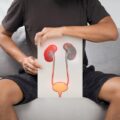Nocturnal emissions is a condition of involuntary loss of semen without sexual act associated with various psychosomatic manifestations. Despite being commonly associated with puberty, they can happen at any age and usually signify normal sexual health.
Nocturnal emissions occur when a person ejaculates semen involuntarily during sleep. This phenomenon is often accompanied by sexual dreams but can also happen without any accompanying dream.
Causes of Nocturnal Emissions
Several factors can contribute to the occurrence of nocturnal emissions, ranging from hormonal changes to psychological stimuli.
Hormonal Changes
During puberty, hormonal fluctuations, particularly increases in testosterone levels, can lead to heightened sexual arousal and subsequently nocturnal emissions.
Sexual Stimuli
Exposure to sexual stimuli, whether in waking life or through dreams, can trigger physiological responses, including erections and ejaculation, during sleep.
Psychological Factors
Stress, anxiety, and unresolved sexual tension can also play a role in the occurrence of nocturnal emissions. These psychological factors can influence the content of dreams and increase sexual arousal during sleep.
Symptoms of Nocturnal Emission
Nocturnal emission, often referred to as “wet dreams,” manifests with several symptoms, both physical and emotional. Understanding these symptoms can help individuals navigate their experiences and alleviate any associated concerns.
Ejaculation During Sleep
The primary physical symptom of nocturnal emission is the involuntary release of semen during sleep. This ejaculation typically occurs during REM (rapid eye movement) sleep stages and may be accompanied by sexual dreams or arousal.
Genital Sensations
Some individuals may experience sensations of warmth, tingling, or pulsation in the genital area preceding a nocturnal emission. These sensations can vary in intensity and duration.
Fatigue Upon Awakening
Following a wet dream, individuals may wake up feeling physically drained or fatigued. This fatigue is often temporary and may dissipate throughout the day.
Embarrassment or Shame
Due to societal stigma or personal beliefs surrounding sexuality, individuals experiencing nocturnal emissions may feel embarrassed or ashamed. These emotions can arise from a lack of understanding or acceptance of the naturalness of wet dreams.
Anxiety or Guilt
Feelings of anxiety or guilt may accompany nocturnal emissions, particularly if they occur frequently or disruptively. Individuals may worry about the implications of their dreams or the perceived loss of control over their bodies.
Myths vs. Facts: Understanding Nocturnal Emission
Myth: Nocturnal emissions are a sign of sexual dysfunction.
Fact: Nocturnal emissions are a natural bodily function and are not indicative of sexual dysfunction. They are a normal occurrence, particularly during adolescence and early adulthood, as the body regulates semen production.
Myth: Wet dreams only occur in adolescence.
Fact: While wet dreams are more common during adolescence due to hormonal changes, they can occur at any age. The frequency may decrease with age, but it is not uncommon for adults to experience occasional nocturnal emissions.
Myth: Nocturnal emissions are caused by sexual fantasies or desires.
Fact: Nocturnal emissions can occur spontaneously during sleep and are not necessarily linked to sexual fantasies or desires. They are a result of the body’s natural processes of semen production and release.
Myth: Nocturnal emissions need to be treated or prevented.
Fact: Nocturnal emissions do not require treatment or prevention. They are a normal part of male physiology and typically do not pose any health risks. However, individuals experiencing distress or discomfort can explore coping strategies or consult a healthcare professional for support.
Physical Implications
Physically, nocturnal emissions do not pose any risks or dangers to health. In fact, they may even help prevent the buildup of old semen in the reproductive system, promoting reproductive health.
Managing Nocturnal Emissions
While nocturnal emission itself does not require treatment, individuals experiencing distress or discomfort may find the following strategies helpful:
- Maintaining a Healthy Lifestyle: Regular exercise, balanced food, and adequate sleep can help regulate hormonal levels and reduce the frequency of wet dreams.
- Stress Management: Practices such as meditation, deep breathing exercises, and relaxation techniques can alleviate stress and promote better sleep quality.Maintain a regular sleep schedule, create a comfortable sleep environment, and avoid excessive screen time before bed.
- Open Communication: Discuss any concerns or questions about wet dreams with a healthcare professional, trusted friend, or partner. Open communication can provide reassurance and alleviate feelings of isolation or shame.
- Psychological Strategies: Addressing underlying stress or anxiety through therapy can help minimize the occurrence of nocturnal emissions triggered by psychological factors.
- Medical Intervention: In rare cases where nocturnal emissions are excessively frequent or causing significant distress, medical intervention, such as hormone therapy or counseling, may be recommended.
- Balanced Nutrition: Consuming a nutritious diet rich in fruits, vegetables, whole grains, and lean proteins can support overall health and hormone balance.
- Normalize the Experience: Remind yourself that nocturnal emission is a natural bodily function experienced by many individuals, particularly during adolescence and early adulthood.
- Avoiding Stimulants: Reduce consumption of caffeine, alcohol, and spicy foods, especially before bedtime.
If nocturnal emissions are causing distress, consider talking to a therapist or counselor for support and coping strategies.
Nocturnal Emission: Gender Differences

Nocturnal emissions, commonly referred to as “wet dreams,” can occur in both men and women, but they manifest differently due to anatomical and physiological differences between genders.
In men, nocturnal emissions involve the involuntary ejaculation of semen during sleep, typically accompanied by sexual dreams or arousal. This phenomenon is a natural part of male reproductive function, often occurring during adolescence and early adulthood due to hormonal changes.
On the other hand, women do not experience nocturnal emissions in the same way as men. While women may have sexual dreams during sleep, they do not ejaculate semen. However, women may experience vaginal lubrication or arousal during sleep, which is a normal physiological response.
Overall, while both men and women may experience sexual arousal or dreams during sleep, the manifestation of nocturnal emissions differs between genders due to biological distinctions.
Risk Factor or Complication of Nocturnal Emission
Risk Factors
- Hormonal Imbalance:
Fluctuations in hormone levels, particularly testosterone, can increase the likelihood of experiencing frequent nocturnal emissions.
- Sexual Activity:
Individuals who engage in infrequent sexual activity or abstain from sexual release may be more prone to nocturnal emissions.
- Psychological Factors:
Stress, anxiety, and other psychological issues can contribute to the frequency of nocturnal emissions.
- Age:
Nocturnal emissions are most common during puberty due to hormonal changes, but they can occur at any age.
Complications
- Psychological Distress:
Some individuals may experience embarrassment, shame, or anxiety due to nocturnal emissions, especially if they occur frequently.
- Sleep Disruption:
Intense or frequent nocturnal emissions can disrupt sleep patterns, leading to fatigue and decreased daytime functioning.
- Relationship Issues:
Misunderstandings or discomfort surrounding nocturnal emissions may impact intimate relationships if not addressed openly and honestly.
- Sexual Dysfunction:
In rare cases, frequent nocturnal emissions may be a symptom of underlying sexual dysfunction, although nocturnal emissions themselves are not typically a cause for concern in this regard.
- Medical Conditions:
While nocturnal emissions are usually harmless, certain medical conditions such as prostate issues or hormonal imbalances may contribute to their frequency or indicate underlying health concerns.
FAQs (Frequently Asked Questions) About Nocturnal Emission
Yes, wet dreams are entirely normal and typically indicate healthy sexual functioning. They are more common during adolescence due to hormonal changes but can occur at any age.
No, wet dreams are not indicative of sexual dysfunction. They are a natural physiological process and do not reflect any underlying sexual problems. However, individuals experiencing distress or discomfort due to nocturnal emissions may benefit from seeking support or guidance from a healthcare
No, nocturnal emissions do not affect fertility. They are unrelated to the reproductive process and do not impact a male’s ability to conceive. However, individuals with concerns about fertility should consult a healthcare professional for personalized advice and guidance.
Yes, it is possible for a man to release sperm without feeling it. This phenomenon, known as a “nocturnal emission” or “wet dream,” occurs during sleep and is typically involuntary. While some individuals may experience physical sensations or dreams associated with ejaculation during a wet dream, others may not be consciously aware of it.
While the frequency of ejaculation may decrease with age, men do not completely stop ejaculating as they age. Factors such as hormonal changes, overall health, and sexual activity levels can influence the frequency of ejaculation. However, it is normal for older men to experience a decrease in both the frequency and intensity of ejaculation compared to their younger counterparts.
There is limited scientific evidence to support the claim that abstaining from ejaculation for seven days increases testosterone levels significantly. While testosterone levels may fluctuate slightly in response to sexual activity, including ejaculation, the impact of short-term abstinence on testosterone levels is not well-established. Testosterone levels are influenced by various factors, including age, overall health, and genetics.
Nocturnal emissions typically start during puberty, which is around the ages of 12 to 16 for most boys.
Conclusion
Nocturnal emissions are a natural and normal part of sexual health that can occur at any age. Understanding the causes and implications of nocturnal emissions can help individuals manage them effectively and alleviate any associated anxieties or misconceptions.




